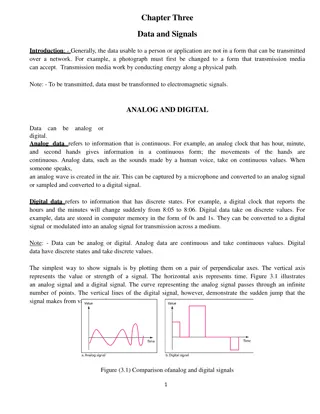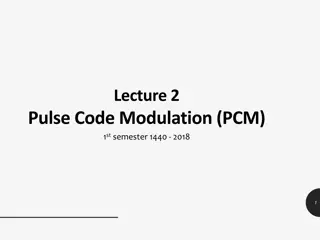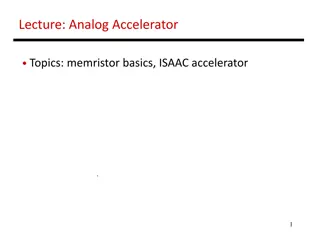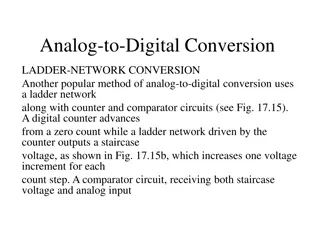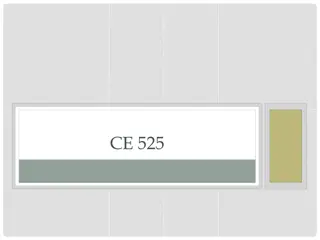Precision Linear Analog Circuit Analysis
Explore the detailed analysis of a precision linear analog circuit, featuring dual feedback configurations, beta values, control loop derivations, and loop gain calculations. The content covers key components, such as operational amplifiers and resistors, and explains how to derive closed-loop gain, set parameters, and measure gains for optimal performance.
Download Presentation

Please find below an Image/Link to download the presentation.
The content on the website is provided AS IS for your information and personal use only. It may not be sold, licensed, or shared on other websites without obtaining consent from the author.If you encounter any issues during the download, it is possible that the publisher has removed the file from their server.
You are allowed to download the files provided on this website for personal or commercial use, subject to the condition that they are used lawfully. All files are the property of their respective owners.
The content on the website is provided AS IS for your information and personal use only. It may not be sold, licensed, or shared on other websites without obtaining consent from the author.
E N D
Presentation Transcript
Dual Feedback Beta+ and Beta- Tim Green Precision Linear Analog Applications April 26, 2017 1
Example Circuit and Control Loop Equivalent VFB- Rf 1kOhm VEE VCC b- Ri 1kOhm V2 15V 4 2 - Vout 6 U2 OPA277 Vin a+ Aol Vout ++ 7 3 V3 15V VFB+ b+ VEE VCC Rip 1kOhm Rfp 9kOhm + Vin 2
Control Loop Derivation Derivation of Closed Loop Gain : Vout = Acl Vin ( Aol ) ( + Aol ) = a + ) + ( b + b Vout Aol Vin Vout ( Vout ) ) b + ( ) b Vin = a + Vout ( Aol Vout Aol Vout ) Aol Vin b + + b = a + Vout 1 ( Aol ) a + Aol ( Vout Aol = b + + b Vin 1 ( Aol ) a + ) a + Vout Aol Aol = = = Acl + b b + + b Vin 1 Aol ( ( ) 1 Aol 1 a + b = Acl 1 + 1 b Aol Aol For Large : a + = Acl _ dc b 3
Beta+, Beta-, a a+ Derivation Rf 1kOhm - VFB- VFB+ VEE Rip 1kOhm Rfp 9kOhm Vout VCC Ri 1kOhm 4 2 - Vout V2 15V 6 Vout is set to GND, since op amp output is viewed, first order, as an AC short. U2 OPA277 + + ++ 7 3 + Vin VFB+ V3 15V VCC VEE Vin Rip 1kOhm Rfp 9kOhm Vin is set to GND since source impedance of Vin is viewed as an AC Short. 4
Example Circuit: Beta+, Beta-, a a+ Derivation + = Derivation (Vin 0V) : a + = Derivation (Vout 0V) : Derivation : + VFB + VFB VFB b + = a + = b = Vout Vin Vout Vout Rip Vin Rfp Vout Ri Rip + + Rip Rfp Rfp + + Ri + Rip Rfp + Ri Rf b + = = a + = = b = = Vout Rip Rfp Vin Rip Rfp Vout Ri Rf k 1 k 1 + 9 + k b = = 5 . 0 b + = = 1 . 0 a + = = 9 . 0 k 1 + k 1 k 1 9 k k 1 9 k 5
Example Circuit: Loop Gain, Acl 1 b a + a + a + Vout Aol Aol + = = = = Acl 1 + b b + b Vin 1 Aol ( ) ( ) 1 Aol + 1 b Aol For Large Aol : a + = Acl _ dc b n : Loop Gai Aol b = Aol * 1 b Magnitude dB on Gain Loop Plot : Aol 1 b 1 b = = = Aol * Aol ( dB ) ( dB ) Aol ( dB ) ( dB ) 1 b b b + ( ) ( ) 6
Example Circuit: Loop Gain, Acl 1 1 a + 9 . 0 Vout . 2 25 b b + ( ) ( ) 5 . 0 ( ) ) 1 . 0 ( = = = = Acl 1 1 1 Vin + + + 1 1 1 b b + 4 . 0 Aol ( ) ( ) Aol 5 . 0 ( ) ) 1 . 0 ( Aol For Large Aol : a + 9 . 0 = = = Acl _ dc . 2 25 . 7 04365 dB b b + ( ) ( ) 5 . 0 ( ) ) 1 . 0 ( Magnitude dB on Gain Loop Plot : 1 b 1 1 1 = = = = 20 Log . 7 9588 dB b b + ( ) ( ) 5 . 0 ( ) ) 1 . 0 ( 5 . 0 ( ) ) 1 . 0 ( 10 Aol 1 b b = = = . 7 Aol * Aol ( dB ) ( dB ) Aol ( dB ) 9588 dB 1 b 7
Example Circuit: Loop Gain + = VFB+ - = VFB- = (VFB-) - (VFB+) 1/ = 1 / [(VFB-) - (VFB+)] Aol= Voa/(-Vdiff) Loop Gain = Voa VFB- Rf 1kOhm Voa VEE Ri 1kOhm VCC 4 2 L1 1TH - Vout 6 V2 15V + ++ 7 3 V U2 OPA277 Vdiff J1 V3 15V VCC VEE Rip 1kOhm Rfp 9kOhm C1 1TF VFB+ J1 + VG1 8
Example Circuit: Loop Gain T 140 Loop Gain = Aol / (1/ ) On dB Plots: Loop Gain = Aol - (1/ ) 120 Aol Aol 100 80 Loop Gain Loop Gain 60.131161dB 60.131161dB Voltage (V) 60 40 52.172328dB 52.172328dB 20 1/ 1/ 0 7.958833dB 7.958833dB -20 -40 1 10 100 1k 10k 100k 1M 10M Frequency (Hz) 9
Example Circuit: Closed Loop Gain, Acl VFB- Rf 1kOhm VEE VCC Ri 1kOhm V2 15V 4 2 - Vout 6 U2 OPA277 ++ 7 3 V3 15V VFB+ VEE VCC Rip 1kOhm Rfp 9kOhm + Vin 10
Measuring Loop Gain in SPICE for Dual Feedback with Beta+ and Beta- (The Double L Break) 12
SPICE Double L Loop Gain Break Derivation FB#1 LM 1T VM Op Amp CT 1T - = Aol b = b b+ Loop Gain + VOA V VFB + ( ) ( - VM VOA VP VOA VOA = ) VG1 + LP 1T VP b = FB#2 b+ = Aol VM VOA VP VOA b = Aol VOA b = Aol VFB Aol Note polarity of meter VFB and VG1 VM VP VM VP VFB = = ( ) 13
SPICE Double L Loop Gain Break Test Rf 1kOhm VM VEE J- U2 OPA277 LM 1TH Ri 1kOhm - Vout LP 1TH + ++ V VFB VFB = Loop Gain (Aol ) J+ VP VCC Rip 1kOhm Rfp 9kOhm CT 1TF J+ "Double L" Loop Break for Loop Gain Analyis Note: Polarity of VG1 Polarity of VFB VCC V2 15V + VG1 J- V3 15V VEE 14
SPICE Double L Loop Gain Break Test 120 T Loop Gain Measured using "Double L" Break 100 80 60 Gain (dB) 40 20 0 -20 -40 -60 0 -45 Phase [deg] -90 -135 -180 1 10 100 1k 10k 100k 1M 10M Frequency (Hz) 15
SPICE Output L Break Test Rf 1k Voa = Loop Gain (Aol ) VEE U2 OPA277 Ri 1k L1 1T - Vout ++ Voa J+ VCC Rip 1k Rfp 9k VCC CT 1T J+ V2 15 + VG1 V3 15 VEE 16
SPICE Output L Break Test matches Double L Break Test ! 120.00 T Loop Gain Measured using "Output L" Break 100.00 80.00 60.00 Gain (dB) 40.00 20.00 0.00 -20.00 -40.00 -60.00 180.00 Phase [deg] 90.00 0.00 1 10 100 1k 10k 100k 1M 10M Frequency (Hz) 17
Why Double L Break is Best 1) For capacitive loads, CL, Double L Break includes effects of Zo in Loop Gain Analysis. VFB = Loop Gain (Aol ) 2) If input op amp capacitance is of concern add Ccm+, Ccm-, Cdiff externally as shown. Rf 1k VM Ccm- 3p VEE J- Ri 1k U2 OPA277 LM 1T - Vout LP 1T + ++ V Cdiff 3p VFB CL 820n J+ Ccm+ 3p VP VCC Rip 1k Rfp 9k VCC CT 1T J+ V2 15 Note: May need Rx and Ry for clean AC results. If too large due to Ibias, lower values. + VG1 Rx 10M J- V3 15 VEE Ry 10M 18






